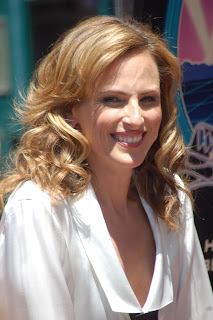 |
Marlee Matlin poses with her new star
on the Hollywood Walk of Fame.
Photo By Sharon Graphics.
Some Rights Reserved.
|
Prior to 1990, Marlee Matlin was a young actress who could appear on television and give interviews, but she could not take part in enjoying the fruits of her labor. She could sit in the room with her family while they watched her appear on the television, but she could not follow what was happening. She could sit on the couch with her family as they watched a rented movie, but she could not hear or understand the words spokent. At this time, closed captioning was not prevalent nor required.
When Marlee was a child, she got started acting in The Wizard of Oz at the International Center on Deafness and the Arts near Chicago. In 1990, the woman who played Dorothy at the age of seven stood before prominent members of congress to fight for that particular movie to be captioned. Marlee wanted to be able to watch and understand what was happening in the film that inspired her young career. After arguing her case, Matlin found that her hard work paid off. Congress voted that, for the first time ever, The Wizard of Oz was to be closed captioned. Not only that, a year later, congress passed a law that all broadcast television must be captioned. The deaf community finally felt they had found victory.
Credits:
N.d. Photograph. Flickr.com. Sharon Graphics. Web. 29 Oct. 2012. http://www.flickr.com/photos/sharongraphics/3509015608/sizes/o/in/photostream/.
"Marlee Matlin FCC Field Hearing Testimony." Marlee Matlin FCC Field Hearing Testimony. National Association of the Dear, 06 Nov. 2009. Web. 29 Oct. 2012. <http://www.nad.org/issues/civil-rights/communications-act/21st-century-act/marlee-matlin-fcc-field-hearing-testimony>.
"Marlee Matlin FCC Field Hearing Testimony." Marlee Matlin FCC Field Hearing Testimony. National Association of the Dear, 06 Nov. 2009. Web. 29 Oct. 2012. <http://www.nad.org/issues/civil-rights/communications-act/21st-century-act/marlee-matlin-fcc-field-hearing-testimony>.
